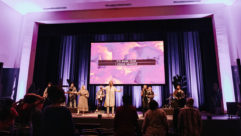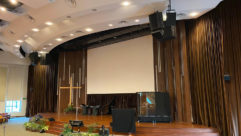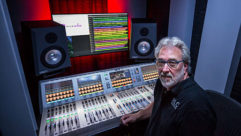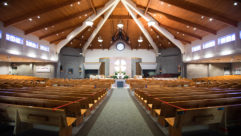Audio is Big News in Small Churches
Feb 16, 2006 8:00 AM
Even among small churches with modest audio needs and budgets, “contractors today can really surprise their clients with what can be done,” says Guy Low, public relations producer at Telex Audio Group, which encompasses such brands as EV, Dynacord, Midas, Klark Teknik, Telex, and RTS.
In fact, he adds, upgrading basic audio capabilities at the so-called “low end” of the worship market is shaping up as a major boom. “As a trend, this is making a major impact,” Low says.
Across the board, vendors of audio systems from simple speakers and microphones to high-end concert support are giving worship applications pride of place in their marketing these days. But for all the attention given to the biggest new installs, industry observers like Low insist the real action is in smaller jobs for smaller clients.
Low says smaller houses of worship typically replace their systems because they have to. The first sound system installed in a small church may well have been stereo-store gear selected and installed by the biggest audiophile in the congregation—or not many steps above that.
When people get impatient with unintelligible sermons, or want to expand their music options, the pastor or another church leader may tiptoe into an area he expects to be complex and costly. That’s when the surprises come, according to Low.
In fact, many audio designers and contractors are offering sophisticated computer acoustical modeling and similar services even for distinctly low-budget jobs. And it isn’t very expensive to put together a powerful and flexible new system.
A typical system might start with good-quality wireless microphones, together with a good pulpit mic, which could be wired or wireless. Low suggests a small-format mixing console for “rudimentary, effective, and simple processing, with possibly a couple of presets.”
Speakers can be chosen virtually off the shelf, Low says, and even relatively inexpensive models deliver “precise directional control across critical bandwidths.” They are easily installed without a major construction commitment. “They don’t have to break the bank,” he notes.
When it comes to choosing components, the market is flooded with both options and advice. Shure, for instance, has a 60-page guide to Audio Systems for Houses of Worship. Company websites often showcase recent installs in churches of all sizes.
EAW, for instance, points to a recent update at St. Joseph’s and St. Patrick’s Church in Escanaba, Mich., in which two small speakers were installed and provided complete sound coverage for a large, high-ceilinged room.
And Telex offers a series of current examples of small churches realizing big-time gains in their audio support. At the Catholic Church of St. Peter in Mendota, Minn., wireless mics, two Midas Venice consoles, and a modest array of EV speakers come together to deliver sound reinforcement to a 650-seat sanctuary. An EASE computer model helped determine the sizing and placement of the speakers.
And at Wooddale Church in Eden Prairie, Minn., a new mixing console made such a difference in the sound that a previously planned purchase of replacement loudspeakers could be re-thought. Another advantage, church leaders said, was that the relatively simple analog mixer was easy for volunteers to learn to operate.
Given the widespread desire of churches to appeal to a younger demographic, and to provide a more involving, interactive worship experience, Low notes that sound reinforcement is often a key element in church planning. “When things sound good,” he said, “people want to participate. It gets the ball rolling.”










